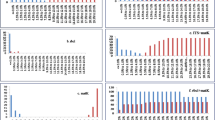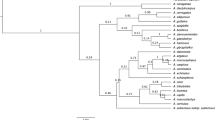Abstract
Among the applications of DNA barcoding for plant conservation is the identification of illegally traded endangered species from small samples or vegetative specimens. DNA barcoding offers an important tool for the phytosanitary authorities to identify species belonging to groups such as the bamboos and orchids, which command high prices in the horticultural trade. In this study we created a DNA barcode library for 20 endangered Orchidaceae species and 36 species of bamboo (Bambusoideae, Poaceae) distributed in Mexico. We applied several metrics to evaluate the efficiency of the barcodes matK and rbcL and, for bamboos, that of the plastid spacer psbI-K. Our results coincide with those of previous barcoding projects in which alone matK allowed for the identification of the most orchid species. For bamboos, the psbI-K spacer retrieved more polymorphic sites and in combination with matK we were able to identify bamboos to at least the generic level.
Resumen
Una de las aplicaciones del código de barras genético en la conservación de plantas es la de identificar especies amenazadas e ilegalmente comerciadas. El código de barras genético puede constituir una herramienta importante para las autoridades fitosanitarias para determinar especímenes de grupos como bambúes y orquídeas, que alcanzan precios elevados en horticultura. En este trabajo se creó una biblioteca de ADN para 20 especies amenazadas de Orchidaceae y 36 especies de bambúes de la subfamilia Bambusoideae distribuidas en México. Se aplicaron varios métodos para evaluar la eficiencia de los códigos de barras matK y rbcL y para los bambúes también se secuenció el espaciador psbI-K. Los resultados coinciden con proyectos previos, en que utilizando únicamente matK es posible identificar más especies de orquídeas. Se encontró una gran variación en las secuencias de psbI-K para bambúes y en combinación con matK fue posible identificar un mayor número de géneros.

Similar content being viewed by others
Literature Cited
Alacs, E. A., A. Georges, N. N. FitzSimmons & J. Robertson. 2010. DNA detective: a review of molecular approaches to wildlife forensics. Forensic Science Medicine and Pathology 6: 180–194.
Asahina, H., J. Shinozaki, K. Masuda, Y. Morimitsu & M. Satake. 2010. Identification of medicinal Dendrobium species by phylogenetic analysis using matK and rbcL sequences. Journal of Natural Medicines 64: 133–138.
Brower, A. V. Z. 2006. Problems with DNA barcodes for species delimitation: ‘ten species’ of Astraptes fulgerator reassessed (Lepidoptera: Hesperiidae). Systematics and Biodiversity 4: 127–132.
CBOL Plant Working Group. 2009. A DNA barcode for land plants. Proceedings of the National Academy of Sciences 106: 12794–12797.
Chow, Y. N. 2010. Orchid smugglers and the use of biotechnology to combat them. Asia-Pacific Journal of Molecular Biology and Biotechnology 18: 175–179.
Cota-Sánchez, J. H., K. Remrchuk & K. Ubayasena. 2006. Ready to use DNA extracted with CTAB method adapted for herbarium specimens and mucilaginous plant tissue. Plant Molecular Biology Reporter 24: 161–167.
Cräutlein, M. V., H. Korpelainen, M. Pietiläinen & J. Rikkinen. 2011. DNA barcoding: a tool for improved taxon identification and detection of species diversity. Biodiversity and Conservation 20: 373–389.
Doyle, J. J. & J. L. Doyle. 1987. A rapid DNA isolation procedure for small quantities of fresh leaf tissue. Phytochemical Bulletin 19: 11–15.
Dunning, L. T. & V. Savolainen. 2010. Broad-scale amplification of matK for DNA barcoding plants, a technical note. Botanical Journal of the Linnean Society 164: 1–9.
Erickson, D. L., J. Spouge, A. Resch, L. A. Weigt & W. J. Kress. 2008. DNA barcoding in land plants: developing standards to quantify and maximize success. Taxon 57: 1304–1316.
Fazekas, A. J., K. S. Burgess, P. R. Kesanakurti, S. W. Graham, S. G. Newmaster, B. C. Husband, D. M. Percy, M. Hajibabaei & S. C. H. Barrett. 2008. Multiple multilocus DNA barcodes from the plastid genome discriminate plant species equally well. PLoS ONE 3: 1–12.
Flores-Palacios, A. & S. Valencia-Díaz. 2007. Local illegal trade reveals unknown diversity and involves a high species richness of wild vascular epiphytes. Biological Conservation 136: 372–387.
Ford, C. S., K. L. Ayres, N. Toomey, N. Haider, J. V. Alphen-Stahl, L. J. Kelly, N. Wikström, P. M. Hollingsworth, R. J. Duff, S. B. Hoot, R. S. Cowan, M. W. Chase & M. J. Wilkinson. 2009. Selection of candidate coding DNA barcoding regions for use on land plants. Botanical Journal of the Linnean Society 159: 1–11.
Gigot, G., J. V. Alphen-Stahl, D. Bogarin, J. Warner, M. W. Chase & V. Savolainen. 2007. Finding a suitable DNA barcode for Mesoamerican orchids. Lankesteriana 7: 200–203.
Goldstein, P. Z. & R. DeSalle. 2011. Integrating DNA barcode data and taxonomic practice: determination, discovery and description. Bioessays 33: 135–147.
Goloboff, P. A., J. S. Farris & K. Nixon. 2003. TNT: tree analysis using new technology. Version 1.0, Beta test v. 0.2. Systematic Biology 54: 176–178.
Hebert, P. D. N. & T. R. Gregory. 2005. The promise of DNA barcoding for taxonomy. Systematic Biology 54: 852–859.
———, S. Ratnasingham & J. R. deWaard. 2003a. Barcoding animal life: cytochrome c oxidase subunit 1 divergences among closely related species. Proceedings of the Royal Society of London B (suppl.) 270: 96–99.
———, A. Cywinska, S. L. Ball & J. R. de Waard. 2003b. Biological identifications through DNA barcodes. Proceedings of the Royal Society of London B 270: 313–32-1.
Janzen, D. H. 2004. Now is the time. Philosophical Transactions of the Royal Society of London B 359: 731–732.
Kress, W. J., D. L. Erickson, F. A. Jones, N. G. Swenson, R. Perez, O. Sanjur & E. Bermingham. 2009. Plant DNA barcodes and community phylogeny of a tropical forest dynamics plot in Panama. PNAS 106: 18621–18626.
———, ———, N. G. Swenson, J. Thompson, M. Uriarte & J. K. Zimmerman. 2010. Advances in the use of DNA barcodes to build a community phylogeny for tropical trees in a Puerto Rican forest dynamics plot. Plos One 5: e15409.
Lahaye, R., V. Savolainen, S. Duthoit, O. Maurin & M. van der Bank. 2008. A test of psbK-psbI and atpF-atpH as potential plant DNA barcodes using the flora of the Kruger National Park as a model system (South Africa). Nature Precedings hd1:10101/npre.2008.1896.1. Posted 16 May 2008.
———, M. van der Bank, D. Bogarin, J. Warner, F. Pupulin, G. Gigot, O. Maurin, S. Duthoit, T. G. Barraclough & V. Savolainen. 2009. DNA barcoding the floras of biodiversity hotspots. Proceedings of the National Academy of Sciences of U.S.A. 105: 2923–2928.
Lobokivov, M. 2003. Bamboo and rattan products and trade. Journal of Bamboo and Rattan 2: 397–406.
Meier, R. 2008. DNA sequences in taxonomy, opportunities and challenges in Wheeler, Q. D. (ed.), The new taxonomy systematics. The Systematics Association Special Volume Series 76: 65–127.
Miller, S. E. 2007. DNA barcoding and the renaissance of taxonomy. Proceedings of the National Academy of Sciences 104: 4775–4776.
Nicolalde-Morejón, F., F. Vergara-Silva, J. González-Astorga, D. W. Stevenson, A. P. Vovides & V. Sosa. 2011. A character-based approach in the Mexican cycads supports diverse multigene combinations for DNA barcoding. Cladistics 27: 150–164.
Palmer, J. D., D. E. Soltis & M. W. Chase. 2004. The plant tree of life: an overview and some points of view. American Journal of Botany 91: 1437–1455.
Ragupathy, S., S. G. Newmaster, M. Murugesan & V. Balasubramaniam. 2009. DNA barcoding discriminates a new cryptic grass species revealed in an ethnobotany study by the Hill tribes of the Western Ghats in southern India. Molecular Ecology Resources 9: 164–171.
Rambaut, A. 2002. Se-Al sequence alignment Editor, V2. 0a11. Department of Zoology. University of Oxford, Oxford.
Rogers, S. O. & A. J. Bendich. 1985. Extraction of DNA from milligram amounts of fresh, herbarium, and mummified plant tissues. Plant Molecular Biology 5: 69–76.
Rozas, J., J. C. Sánchez-Del Barrio, X. Messeguer & R. Rozas. 2003. DnaSP, DNA polymorphism analyses by the coalescent and other methods. Bioinformatics 19: 2496–2497.
Ruiz-Sanchez, E., V. Sosa & M. T. Mejia-Saules. 2008. Phylogenetics of Otatea inferred from morphology and chloroplast DNA sequence data and recircumscription of Guaduinae (Poaceae: Bambusoideae). Systematic Botany 33: 277–283.
———, ——— & ———. 2011. Molecular phylogenetics of the Mesoamerican bamboo Olmeca (Poaceae, Bambuseae): Implications for taxonomy. Taxon 60: 89–98.
Schindel, D. E. & S. E. Miller. 2005. DNA barcoding a useful tool for taxonomists. Nature 435: 17.
SEMARNAT. 2001. Norma Oficial Mexicana NOM-059-ECOL-2001. Protección ambiental – Especies nativas de México de flora y fauna silvestres – Categorías de riesgo y especificaciones para su inclusión, exclusión o cambio – Lista de especies en riesgo. Diario Oficial de la Federación. México.
Stoeckle, M. Y. & P. D. Hebert. 2008. Bar code of life: DNA tags help classify life. Scientific American 299: 82–88.
Tamura, K., D. Peterson, N. Peterson, G. Stecher, M. Nei & S. Kumar. 2011. MEGA5: Molecular evolutionary genetics analysis using maximum likelihood, evolutionary distance, and maximum parsimony methods. Molecular Biology and Evolution 28: 2731–2739.
Vijayan, K. & C. H. Tsou. 2011. DNA barcoding in plants: taxonomy and a new perspective. Current Science 99: 1530–1541.
Vovides, A. P. 2000. México: segundo lugar mundial en diversidad de cícadas. Biodiversitas 6: 6–10.
Acknowledgments
We thank Javier Francisco Ortega and Angélica Cibrián for inviting us to the “ADN y la conservación de la diversidad vegetal en América Latina” symposium, part of the “X Congreso Latinoamericano de Botánica” in La Serena, Chile (October, 2010). We acknowledge funding from CONABIO (HB004 “Barcode de bambúes nativos de México”). We thank Arith Pérez and Claudia Navarro for assisting with the lab work. Bianca Delfosse improved the English. Ismael Guzmán-Valdivieso and José M. Pech helped with the analyses. Eduardo Ruiz Sanchez helped collect the bamboos and Milton Díaz helped collect the orchids. Sequencing the Orchidaceae was part of the B.Sc. thesis project carried out at the Universidad Veracruzana by the third author of this paper.
Author information
Authors and Affiliations
Corresponding author
Appendix 1
Appendix 1
Rights and permissions
About this article
Cite this article
Sosa, V., Mejía-Saules, T., Cuéllar, M.A. et al. DNA Barcoding in Endangered Mesoamerican Groups of Plants. Bot. Rev. 79, 469–482 (2013). https://doi.org/10.1007/s12229-013-9129-4
Published:
Issue Date:
DOI: https://doi.org/10.1007/s12229-013-9129-4




